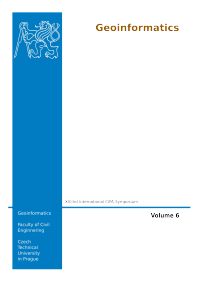Photo-Realistic 3D Modelling of Sculptures on Open-Air Museums
DOI:
https://doi.org/10.14311/gi.6.12Keywords:
terrestrial laser scanning, cultural heritage, documentation, data acquisition, 3D modelling, visualizationAbstract
Laser scanning is a high-end technology with possibilities far ahead the well-known civil engineering and industrial applications. The actual geomatic technologies and methodologies for cultural heritage documentation allow the generation of very realistic 3D results used for many scopes like archaeological documentation, digital conservation, 3D repositories, etc. The fast acquisition times of large number of point clouds in 3D opens up the world of capabilities to document and keep alive cultural heritage, moving forward the generation of virtual animated replicas of great value and smooth multimedia dissemination. This paper presents the use of a terrestrial laser sca nning (TLS) as a valuable tool for 3D documentation of large outdoor cultural heritage sculptures such as two of the existing ones inside the “Campus de Vera” of the UPV: “Defensas I” and “Mentoring”. The processing of the TLS data is discussed in detail in order to create photo-realistic digital models. Data acquisition is conducted with a time-of-flight scanner, characterized by its high accuracy, small beam, and ultra-fine scanning. Data processing is performed using Leica Geosystems Cyclone Software for the data registration and 3DReshaper Software for modelling and texturing. High-resolution images after calibration and orientation of an off-the-shelf digital camera are draped onto the models to achieve right appearance in colour and texture. A discussion on the differences found out when modelling sculptures with different deviation errors will be presented. Processing steps such as normal smoothing and vertices recalculation are found appropriate to achieve continuous meshes around the objects.References
United Nations Educational, Scientific and Cultural Organization: Guidelines for the preservation of digital heritage, http://unesdoc.unesco.org/images/0013/001300/130071e.pdf, 2011-04-15.
Böhler,W. et al.: 3D scanning and photogrammetry for heritage recording: a comparison, 12th International Conference on Geoinformatics - Geospatial Information Research: Bridging the Pacific and Atlantic, Universidad de Gävle, Suecia, Junio 2004, 291-298.
Patias, P.: Cultural Heritage Documentation, International Summer School “Digital Recording and 3D Modeling”, Aghios Nikolaos, Crete, Greece, 24-29 April 2006.
Lerma García, J.L., Van Genechten B. , Santana Quintero M.: 3D Risk Mapping. Theory and Practice on Terrestrial Laser Scanning. Training Material Based on Practical Applications. Universidad Politécnica de Valencia, Valencia 2008, 261 pp.
English Heritage: 3D laser scanning for heritage. Advice and guidance to users on laser scanning in archaeology and architecture http://www.helm.org.uk/upload/pdf/publishing-3d-laser-scanning-reprint.pdf , 2007.
Cabrelles N., Galcerá S., Navarro S., Lerma J.L., Akasheh T., Haddad N.: Integration of 3D laser scanning, photogrammetry, thermography to record architectural monuments, Proceedings of CIPA 2009, Kyoto, Japan, 11-15 Oct. 2009, pp. 6.
Al-kheder, S., Al-shawabkeh, Y., and Haala, N.: Developing a documentation system for desert palaces in Jordan using 3D laser scanning and digital photogrammetry, Journal of Archaeological Science, 2009, 36, 537-546.
Lerma J.L., Navarro S., Cabrelles N., Villaverde V.,: Terresrial Laser Scanning and close range photogrammetry for 3D archaeological documentation: the upper palaeolithic cave of Parpallò as a case of study, Journal of Archaeological Science, 37 (3), 2010, 499-507.
Remondino F., Rizzi A.: Reality-based 3D documentation of natural and cultural heritage sites-techniques, problems, and examples, Appl Geomat (2010) 2, 85-100
Ikeuchi K., Miyazaki D.: Digitally archiving cultural objects. Springer, New York, 2008, 503 pp. ISBN: 978-0387-75806-0
Ruther H.: Documenting Africa’s Cultural Heritage, Proceedings of VAST 2010, Archaeology and Cultural Heritage, Paris, September 2010.
Apollonio, F.I., Corsi, C., Gaiani, M., Baldissini, S.,: An integrated 3D geodatabase for Palladio’s work. Int. Journal of Architectural Computing, 2010, 2(8).
Ikeuchi K., Oishi T., Takamatsu J.: Digital bayon temple e-monumentalization of large-scale cultural-heritage objects, Proceeding of ASIAGRAPH 2007, Shanghaii, 2007, 1 (2), 99-106.
Levoy M, Pulli K, Curless B, Rusinkiewicz S, Koller D, Pereira L, Ginzton M, Anderson S, Davis J, Ginsberg J., Shade J., Fulk D.:The digital Michelangelo project: 3d scanning of large statues, Proceedings SIGGRAPH 2000, New Orleans, Louisiana, USA, July 2000, 131-144.
Remondino F., Girardi, S., Rizzi A., Gonzo, L.: 3D modeling of complex and detailed cultural heritage using multi-resolution data, Journal on Computing and Cultural Heritage 2(2009)1, 2:1-2:20
Universidad Politécnica de Valencia: Campus en Tercera Dimensión: (primera fase), Universidad Politécnica de Valencia, Valencia 1993, 73 pp.
Leica Geosystems: Leica ScanStation 2 Product Specifications, http://hds.leicageosystems.com/downloads123/hds/hds/ScanStation/brochures-datasheet/Leica_ScanStation%202_datasheet_us.pdf, 2011-05-19.
DReshaper 5.3 Tutorial, 2010, http://www.3dreshaper.com.
Downloads
Published
Issue
Section
License
- Authors retain copyright and grant the journal right of first publication with the work simultaneously licensed under a Creative Commons Attribution License that allows others to share the work with an acknowledgement of the work's authorship and initial publication in this journal.
- Authors are able to enter into separate, additional contractual arrangements for the non-exclusive distribution of the journal's published version of the work (e.g., post it to an institutional repository or publish it in a book), with an acknowledgement of its initial publication in this journal.
- Authors are permitted and encouraged to post their work online (e.g., in institutional repositories or on their website) prior to and during the submission process, as it can lead to productive exchanges, as well as earlier and greater citation of published work (See The Effect of Open Access).

